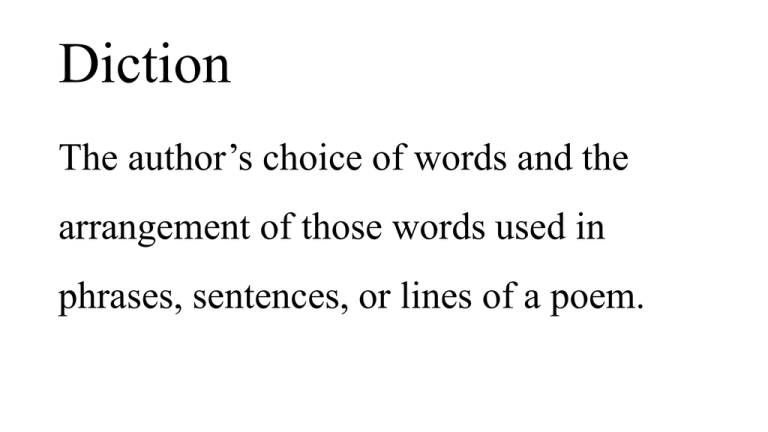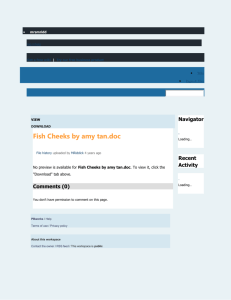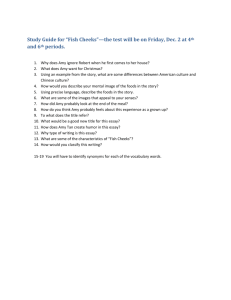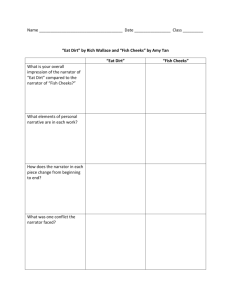Diction
advertisement

Diction The author’s choice of words and the arrangement of those words used in phrases, sentences, or lines of a poem. Characterization The various literary means by which characters are presented (e.g. developing, flat, foil, round, static, stock) Flat Character •A character whose distinguishing moral qualities or personal traits are summed up in one or two traits. •Example: Amy Tan’s relatives from “Fish Cheeks” will always be viewed as noisy and rude by the minister’s son. Round character •A character whose distinguishing moral qualities or personal traits are complex and many-sided. •Example: Amy Tan in “Fish Cheeks.” Static Character •A character who is the same sort of person at the end of a work as at the beginning. •Robert, the minister’s son in “Fish Cheeks” Dynamic (developing) character •A character who during the course of a work undergoes a permanent change in some distinguishing moral qualities or personal traits or outlook. •Amy Tan in “Fish Cheeks” Foil Character •A minor character whose situation or actions parallel those of a major character, and thus by contrast sets off or illuminates the major character; most often the contrast is complimentary to the major character. •Amy Tan’s mother in “Fish Cheeks” Mood •Mood is the emotions that you feel while you are reading. Some literature makes you feel sad, others joyful, still others, angry. •The general atmosphere created by the author’s words and imagery. •Types of mood: scary, romantic, violent, hopeful, mysterious, joyful. . . Tone •Tone - the manner in which written words might be said. For example: sarcastic, hateful, witty, angry •Tone is different from mood in that a story typically has one mood; whereas, tone can change a lot throughout a story. Stereotype A character who is so ordinary or unoriginal that the character seems like an oversimplified representation of a type, gender, class, religious group, or occupation. Audience The particular group of readers or viewers that the writer is addressing. A writer considers his or her audience when deciding on a subject, a purpose for writing, and the tone and style in which to write. Stock Character •A stereotyped character, one whose nature is familiar to us from prototypes in previous literature. •E.g. Jiminey Cricket, Cinderella… Imagery A rather vague critical term covering those uses of language in a literary work that evokes senseimpressions by literal or figurative reference to perceptible or concrete objects, scenes, actions, or states as distinct from the languages of abstract argument or exposition. Simile •A figure of speech in which an explicit comparison is made between two things essentially unlike. The comparison is made explicit by the use of some such word or phrase as like, as, than, similar to, resembles, or seems. Personification •A figure of speech in which human attributes are given to an animal, an object, or a concept. •“A slimy rock cod…that pleaded not to be thrown..” Allusion •A reference, explicit or implicit, to something in previous literature, art, or history. • “…as white as Mary in the manger.” Hyperbole •Great exaggeration used for emphasis or effect. •“This backpack weighs a ton!!” Protagonist The main character of a story—often considered to be the hero of the story. Antagonist The character who frustrates, deceives, fights or works against the main character. Connotation The range of further associations that a word or phrase suggests in addition to its straightforward denotation, the literal dictionary meaning of a word




